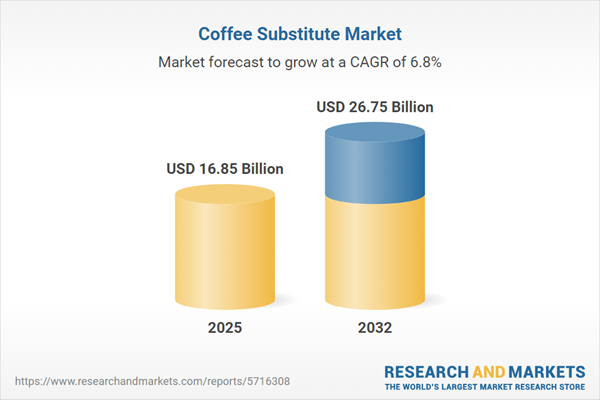Speak directly to the analyst to clarify any post sales queries you may have.
The coffee substitute market is in a phase of rapid evolution, with organizations responding actively to changing consumer health values, new wellness priorities, and shifts in procurement strategy. Senior decision-makers now face the challenge—and opportunity—of reshaping their offerings and operational models to ensure continued relevance and leadership.
Coffee Substitute Market Snapshot
The global coffee substitute market reached USD 15.76 billion in 2024, and is projected to reach USD 26.75 billion by 2032, reflecting a CAGR of 6.84%. This growth is powered by a move towards caffeine-free beverages tied to wellness and employee health objectives within organizations. Companies are evolving their portfolios, digital outreach, and messaging to address a more health-focused customer base. Heightened industry competition and shifting procurement needs require ongoing investments in product development, adaptive channel management, and regionally tuned market strategies.
Coffee Substitute Market Scope & Segmentation
- Product Types: Barley, carob, chicory, dandelion, herbal blends, and malt offer companies the ability to nurture loyal customers while expanding into health-driven market segments.
- Distribution Channels: Foodservice, hypermarkets, supermarkets, convenience stores, digital direct-to-consumer, third-party online marketplaces, and specialty retail increase access for B2B buyers and consumers, optimizing reach and visibility.
- Forms: Granules, instant powders, liquid concentrates, roasted, and ground options allow flexibility in procurement and adapt to wide user requirements across continents.
- End Users: Commercial enterprises and households drive the need for bulk supply as well as customizable solutions to accommodate both business and individual consumption patterns.
- Packaging Formats: Bulk bags, cans, sachets, and single-serve pods enable streamlined logistics, catering to procurement groups and retail buyers who prioritize convenience and efficiency.
- Price Ranges: Products span economy, mid-range, and premium to serve different demographics and support adaptable pricing in diverse economic settings.
- Ingredient Types: Single-ingredient and blended variants position companies to meet regulatory, dietary, and labeling requirements in multiple jurisdictions.
- Regional Coverage: Americas, Europe, Middle East & Africa, and Asia-Pacific require tailored marketing approaches and localized supply chain solutions to address unique buyer behaviors and compliance mandates.
- Key Companies Profiled: Nestlé S.A., Kraft Heinz Company, The Roasted Grain Company, Barleycup International Limited, Dandy Blend Limited, Inka Food Sp. z o.o., and Post Consumer Brands lead innovation, establish distribution networks, and influence competitive strategies across global markets.
Coffee Substitute Market: Key Takeaways for Senior Decision-Makers
- Barley and chicory-based offerings are sparking renewed interest from B2B procurement, supporting repositioning strategies focused on health-conscious organizations.
- Expanding digital-first distribution strengthens engagement with both customers and procurement leaders, aligning with new sales models and shifting buying preferences.
- Supply chain agility and variable manufacturing approaches increase responsiveness to regulatory shifts and changing customer demands.
- Improved transparency and traceability reinforce procurement group trust and help ensure compliance, especially in tightly regulated regions.
- Localized product marketing and adaptation foster ongoing competitive relevance and long-term growth across geographies.
- Collaboration among suppliers, manufacturers, and foodservice partners reduces time-to-market and enhances compliance workflows, maximizing overall operational efficiency.
Tariff Impact: Navigating US Policy Changes
Recent US tariff adjustments affecting barley and carob imports have prompted companies to strengthen domestic sourcing and revise regional distribution strategies. Organizations are actively rebalancing digital engagement priorities, updating risk management frameworks, and optimizing loyalty initiatives and packaging formats to manage increased cost pressures. This evolving environment underscores the importance of operational flexibility and continuous compliance monitoring as tariff and pricing issues remain central to strategic planning.
Methodology & Data Sources
This report combines direct input from executive interviews, feedback from buyers and end users, and up-to-date industry analyses. Recognized tools, including SWOT and PESTEL frameworks, support the development of market intelligence designed for procurement and strategic planning needs.
Why This Report Matters
- Identifies areas of high growth and innovation, allowing leadership teams to target investment and product development for maximum impact.
- Enables comprehensive market entry strategies, efficient procurement processes, and agile digital marketing aligned with evolving buyer expectations.
- Provides clarity on competitive dynamics and highlights pressing supply chain risks, guiding organizations in preparing for continued market transformation.
Conclusion
With these insights, senior decision-makers can recalibrate their operational strategies and stay ahead in the coffee substitute market, driving sustained competitiveness and organizational relevance in a shifting landscape.
Additional Product Information:
- Purchase of this report includes 1 year online access with quarterly updates.
- This report can be updated on request. Please contact our Customer Experience team using the Ask a Question widget on our website.
Table of Contents
3. Executive Summary
4. Market Overview
7. Cumulative Impact of Artificial Intelligence 2025
Companies Mentioned
The companies profiled in this Coffee Substitute market report include:- Nestlé S.A.
- Kraft Heinz Company
- The Roasted Grain Company, Inc.
- Barleycup International Limited
- Dandy Blend Limited
- Inka Food Sp. z o.o.
- Post Consumer Brands, LLC
Table Information
| Report Attribute | Details |
|---|---|
| No. of Pages | 196 |
| Published | October 2025 |
| Forecast Period | 2025 - 2032 |
| Estimated Market Value ( USD | $ 16.85 Billion |
| Forecasted Market Value ( USD | $ 26.75 Billion |
| Compound Annual Growth Rate | 6.8% |
| Regions Covered | Global |
| No. of Companies Mentioned | 8 |









